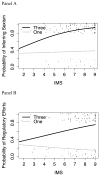Value-Based Standards Guide Sexism Inferences for Self and Others
- PMID: 29230069
- PMCID: PMC5722271
- DOI: 10.1016/j.jesp.2017.04.006
Value-Based Standards Guide Sexism Inferences for Self and Others
Abstract
People often disagree about what constitutes sexism, and these disagreements can be both socially and legally consequential. It is unclear, however, why or how people come to different conclusions about whether something or someone is sexist. Previous research on judgments about sexism has focused on the perceiver's gender and attitudes, but neither of these variables identifies comparative standards that people use to determine whether any given behavior (or person) is sexist. Extending Devine and colleagues' values framework (Devine, Monteith, Zuwerink, & Elliot, 1991; Plant & Devine, 1998), we argue that, when evaluating others' behavior, perceivers rely on the morally-prescriptive values that guide their own behavior toward women. In a series of 3 studies we demonstrate that (1) people's personal standards for sexism in their own and others' behavior are each related to their values regarding sexism, (2) these values predict how much behavioral evidence people need to infer sexism, and (3) people with stringent, but not lenient, value-based standards get angry and try to regulate a sexist perpetrator's behavior to reduce sexism. Furthermore, these personal values are related to all outcomes in the present work above and beyond other person characteristics previously used to predict sexism inferences. We discuss the implications of differing value-based standards for explaining and reconciling disputes over what constitutes sexist behavior.
Keywords: inferences; sexism; standards; values.
Figures




Similar articles
-
When sexism is not a problem: The role of perceived intelligence in willingness to interact with someone who is sexist.J Soc Psychol. 2021 May 4;161(3):287-303. doi: 10.1080/00224545.2020.1819187. Epub 2020 Sep 22. J Soc Psychol. 2021. PMID: 32959723
-
Polyculturalism and Sexist Attitudes: Believing Cultures are Dynamic Relates to Lower Sexism.Psychol Women Q. 2014 Dec;38(4):519-534. doi: 10.1177/0361684313510152. Psychol Women Q. 2014. PMID: 25530662 Free PMC article.
-
Judging the gender of the inanimate: Benevolent sexism and gender stereotypes guide impressions of physical objects.Br J Soc Psychol. 2017 Sep;56(3):537-560. doi: 10.1111/bjso.12198. Epub 2017 May 2. Br J Soc Psychol. 2017. PMID: 28466538
-
An ambivalent alliance. Hostile and benevolent sexism as complementary justifications for gender inequality.Am Psychol. 2001 Feb;56(2):109-18. Am Psychol. 2001. PMID: 11279804 Review.
-
Barriers to women engaging in collective action to overcome sexism.Am Psychol. 2016 Dec;71(9):863-874. doi: 10.1037/a0040345. Am Psychol. 2016. PMID: 28032778 Review.
Cited by
-
A Gender Bias Habit-Breaking Intervention Led to Increased Hiring of Female Faculty in STEMM Departments.J Exp Soc Psychol. 2017 Nov;73:211-215. doi: 10.1016/j.jesp.2017.07.002. Epub 2017 Aug 17. J Exp Soc Psychol. 2017. PMID: 29249837 Free PMC article.
-
Parents' Expectations for and Reactions to Children's Racial Biases.Child Dev. 2020 May;91(3):769-783. doi: 10.1111/cdev.13231. Epub 2019 Mar 2. Child Dev. 2020. PMID: 30825398 Free PMC article.
References
-
- Amodio DM, Devine PG, Harmon-Jones E. A dynamic model of guilt: Implications for motivation and self-regulation in the context of prejudice. Psychological Science. 2007;18:524–530. - PubMed
-
- Barreto M, Ellemers N. Sexism in contemporary societies: How it is expressed, perceived, confirmed, and resisted. The SAGE handbook of gender and psychology. 2013:288–305.
-
- Biernat M, Ma JE, Nario-Redmond MR. Standards to suspect and diagnose stereotypical traits. Social Cognition. 2008;26:288–313.
-
- Blanchard FA, Lilly T, Vaughn LA. Reducing the expression of racial prejudice. Psychological Science. 1991;2:101–105.
-
- Blodorn A, O’Brien LT, Kordys J. Responding to sex-based discrimination: Gender differences in perceived discrimination and implications for legal decision making. Group Processes & Intergroup Relations. 2012;15:409–424.
Grants and funding
LinkOut - more resources
Full Text Sources
Other Literature Sources
